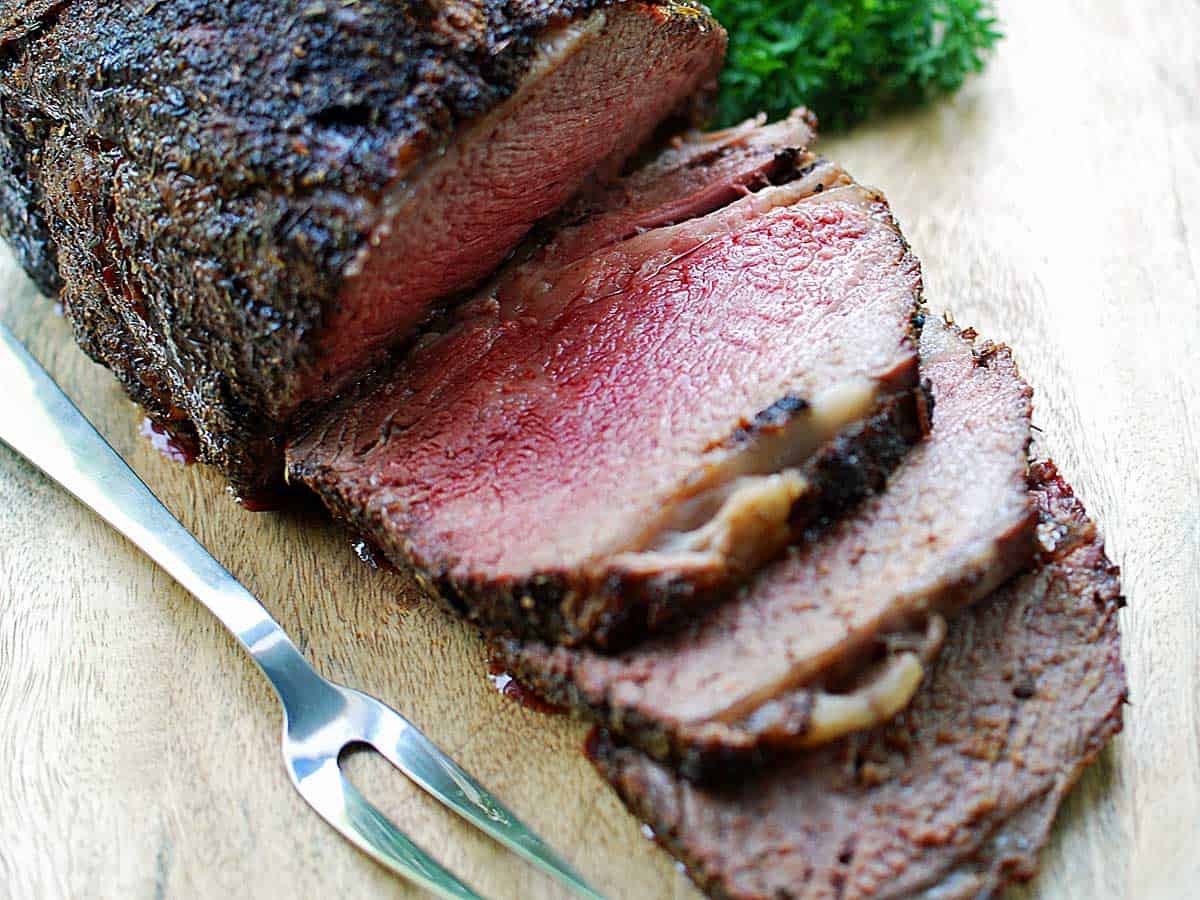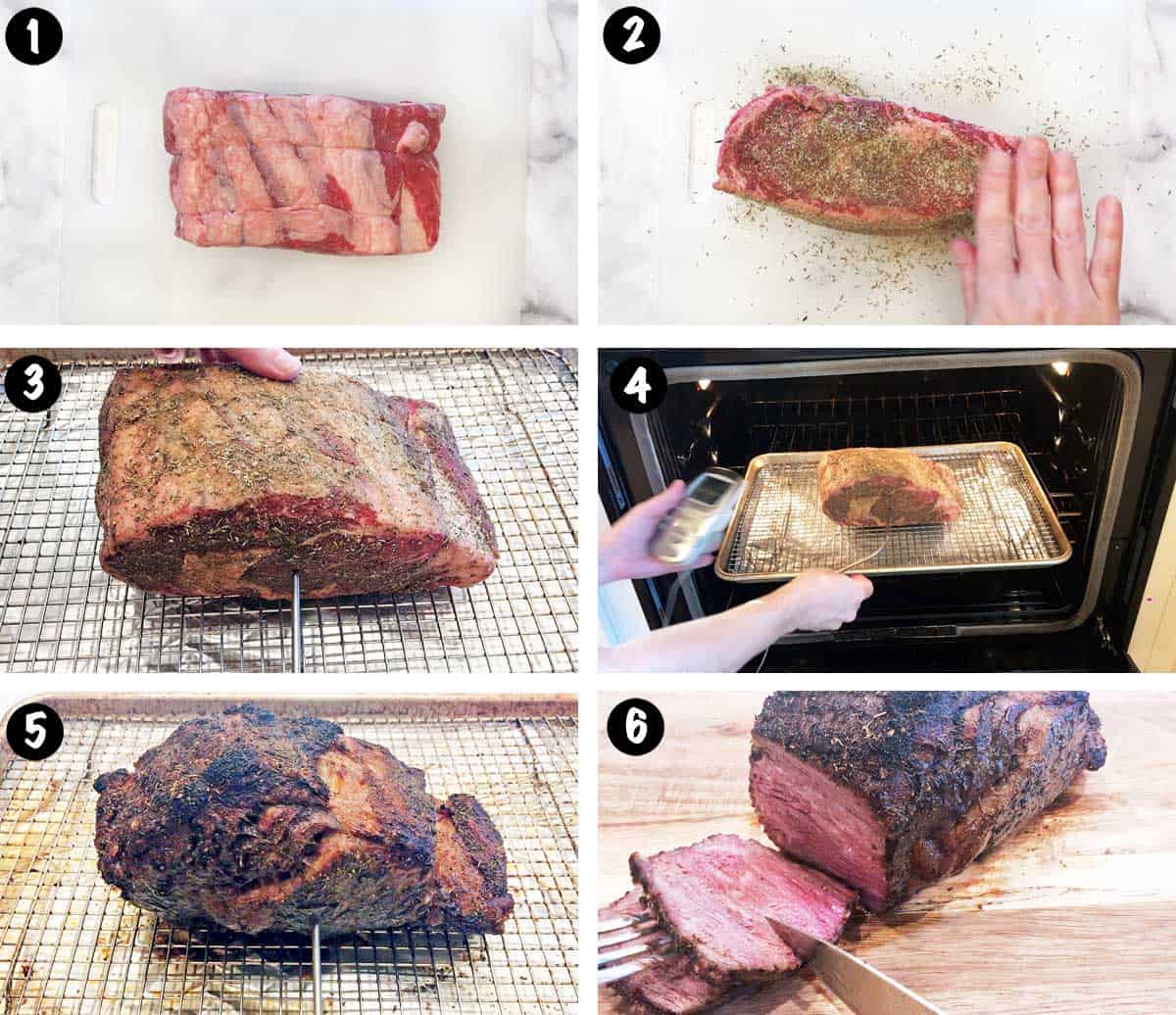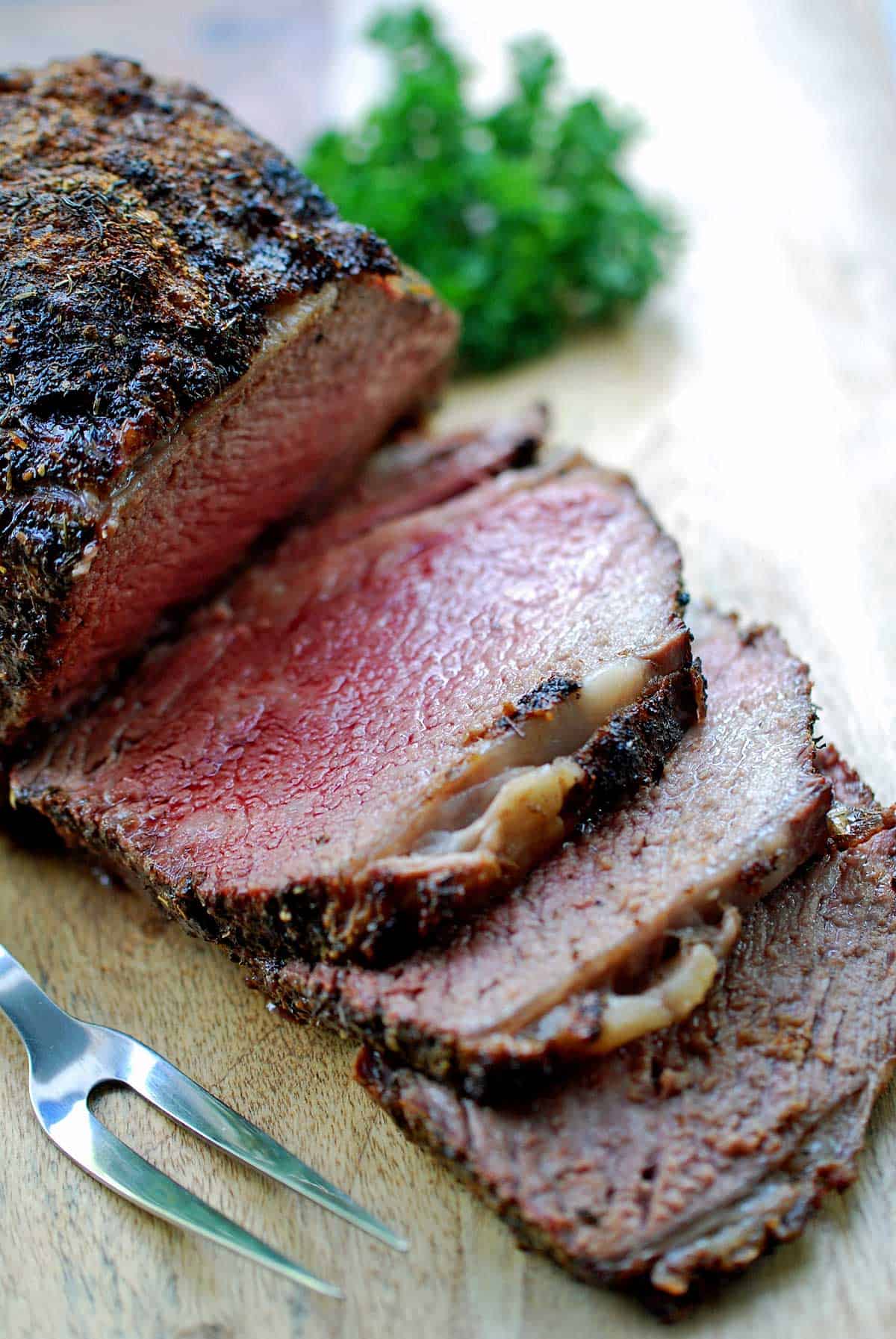Rib on Bone Roast Beef Recipe
A simple dry rub and 75 minutes in the oven are all it takes to produce a beautifully marbled, flavorful, and juicy ribeye roast.
There's no need to marinate the meat prior to cooking, and you can enjoy the leftovers reheated or cold.

Tender, succulent, and very flavorful, ribeye is my favorite cut of beef. And this tasty recipe for cooking the whole roast is especially easy to make.
Simply rub the meat with seasonings, then cook it in the oven until done. Your only real job as a cook is to avoid overcooking the meat.
Jump to:
- Ingredients
- Instructions
- Expert tip
- Frequently asked questions
- Serving suggestions
- Storing leftovers
- Related recipes
- Recipe card
Ingredients
You'll only need a few simple ingredients to make this very festive roast. The exact measurements are listed in the recipe card below. Here's an overview of what you'll need:
To season the meat: Kosher salt, black pepper, garlic powder, dried sage, and dried thyme.
Ribeye roast: I like to pick a 3-lb. piece. If possible, get a USDA prime grade, the highest beef grade.
Instructions
The best thing about this recipe is that it's so very easy. Simply rub the meat with seasonings. Roast it in a very hot oven (500°F) to get the fat cap crispy, then lower the oven temperature to 350°F and continue roasting to medium-rare.
If you use an instant-read meat thermometer (as you should), you will know exactly when to take the meat out of the oven. Conventional wisdom says that after the initial high-heat roasting, you'll need 20 minutes in the 350°F oven for each pound of meat you cook.
So for a 3 lb. roast, this SHOULD take roughly 1 more hour. But for me in my oven, after that one more hour, the internal temperature usually reaches 120°F, and I need to keep roasting for 8-9 more minutes to reach 135°F.

Expert tip
It's very important to let the meat rest for 30 minutes before slicing it. This will allow the juices to settle and redistribute, preventing all the yummy juices from gushing out as soon as you cut into the meat.
There's nothing sadder for a meat lover than cutting into a roast too soon and watching all the juices gush into the cutting board!
Frequently asked questions
Are prime rib and ribeye roast the same thing?
Almost, but not exactly. Prime rib is cut from the prime, superior portion of the animal, where the meat is especially tender and well-marbled. It includes ribs 6 through 12.
Prime rib is sometimes called a standing rib roast because the bones enable it to stand upright for roasting. But if you cut the meat away from the bones, leaving the "eye" (the large central muscle) and a layer of fat, then that's a ribeye roast.
Some say that it's best to cook bone-in roasts because the bones produce a juicier and more flavorful roast. It's true that the meat portions closest to a bone-in steak, for example, taste the best. But it's also true that it's difficult to get to them unless you're willing to gnaw on bones!
That's why many home cooks, myself included, prefer to cook a ribeye roast. It is smaller, and you can carve it easily since there are no bones. It is still very flavorful, and the fat cap is sublime.
What's the difference between a roast and a steak?
A ribeye steak is essentially a prime rib roast, cut between the ribs into individual steaks. 🥩
A roast is slowly cooked in the oven, while steak is typically pan-fried, grilled, or broiled.
Many people actually prefer to buy whole boneless roasts and cut them into individual steaks. Costco has great roasts, by the way, and if you do it this way, you could save quite a bit.
Should I marinate the meat before roasting?
You could, but personally, I don't bother. The meat is so well-marbled, beefy and juicy, that it tastes great without any marinade.
Unlike tough cuts of beef such as London broil, ribeye is also tender enough so that you don't need a vinegary marinade to tenderize it.
To what temperature should I cook this roast?
Since this roast is so amazingly delicious, I always assumed that it's not something that I would want to tackle at home. I thought it would be too complex.
But as it turns out, it's very easy to make this recipe at home in your oven. This is especially true if you have a meat thermometer to help ensure you don't overcook (or undercook) the meat. It's best to cook it to medium-rare (135°F).
Having said that, ribeye is marbled and juicy enough that it should taste good even when you cook it to medium doneness (145°F), as recommended by the USDA. Although that's not my personal preference.
What is the best cut of beef?
Ribeye! At least that's my opinion. But I'm not alone in feeling this way.
I used to love filet mignon - beef tenderloin. Relatively lean and very tender, filet mignon is good, but it pales compared to the fatty, juicy, well-marbled ribeye. And this is true for steaks as well as for roasts.
I tried prime rib for the first time at "The Prime Rib" restaurant in Washington DC, many years ago. It was one of those first experiences that you cherish forever.
My first bite into the juicy, succulent roast was unforgettable. I knew right then and there that ribeye is my favorite cut of beef, and that slow cooking is my favorite method of preparing it. Although reverse-seared ribeye steaks are also excellent.
I ordered the prime rib with a side of buttery mashed potatoes. After finishing about half my meat, I took a bite of the potatoes. They were sublime! But I quickly realized that due to my limited stomach capacity I would have to choose - either finish the ribeye or eat the mashed potatoes.
I chose the meat, which was unheard of back in my high-carb days. That's how good it was!
Serving suggestions
I recommend balancing out the richness of the meat by skipping the starch altogether and serving it with simply prepared veggies such as sautéed broccolini or steamed green beans.
A simple green salad such as this arugula salad is always good. And if you want a tasty alternative to mashed potatoes, try mashed cauliflower. Or go all out with loaded mashed cauliflower!
Storing leftovers
Leftovers keep well in the fridge, in an airtight container, for 3 to 4 days. Reheat them very gently, covered, in the microwave on 50% power. Reheating does, unfortunately, take them from medium-rare to medium doneness, but this can't be helped.
Unless you simply slice them very thin and eat them cold! They are surprisingly good this way, served with Dijon mustard, quick pickles, and fresh-cut veggies. Kind of like eating cold roast beef.

-
Cast-Iron Boneless Ribeye Steak
-
Beef Tenderloin Roast
-
Reverse Sear Steak
-
Flat Iron Steak
👩🏻🍳 I typically publish a new or an updated recipe once a week. Want these recipes in your inbox? Subscribe! You can unsubscribe at any time.
Recipe card
Ribeye Roast Recipe
Tender, succulent and very flavorful, ribeye roast is surprisingly easy to make at home. Simply rub the meat with seasonings, then cook in the oven until done.
Servings: 8 servings
Calories: 450 kcal
- 2 teaspoons Diamond Crystal kosher salt (not fine salt)
- 1 teaspoon black pepper
- 1 teaspoon garlic powder
- 1 teaspoon dried sage
- 1 teaspoon dried thyme
- 3 lb. boneless ribeye roast USDA prime grade
-
In a small bowl, use a fork to mix together the kosher salt, black pepper, garlic powder, sage, and thyme. Rub all over the roast, pressing to make sure the rub adheres to the meat.
-
Place the meat, fat side up, on a rack in a roasting pan and allow it to get to room temperature, about 1 hour.
-
Preheat the oven to 500°F. Insert a meat thermometer into the middle of the roast and set the thermometer to 135°F (medium-rare).
-
Place the roast in the 500°F oven and cook it for 15 minutes.
-
Reduce the oven temperature to 350°F. Keep roasting the meat until the thermometer registers 135°F. For a 3 lb. roast, this SHOULD take roughly 1 more hour (20 minutes per pound) according to conventional wisdom. But the only way to know for sure is to use a thermometer. For me in my oven, after that one more hour, the internal temperature usually reaches 120°F, and I need to keep roasting for 8-9 more minutes to reach 135°F.
-
Remove the roast from the oven. Loosely cover it with foil and allow it to rest for 30 minutes, then cut it into thin slices and serve.
The only way to ensure the meat is done to your liking is to use a meat thermometer.
It's very important to let the roast rest for 30 minutes before slicing it. This will allow the juices to settle and redistribute, preventing all the yummy juices from gushing out as soon as you cut into the meat.
Nutrition info assumes USDA prime (fattier), and fat eaten.
The USDA says we should cook whole cuts of beef to medium.
Leftovers keep well in the fridge, in an airtight container, for 3 to 4 days.
Most of our recipes are low-carb (or keto) and gluten-free, but some are not. Please verify that a recipe fits your needs before using it. Recommended and linked products are not guaranteed to be gluten-free. Nutrition info is approximate and the carb count excludes sugar alcohols. Nutrition info may contain errors, so please verify it independently. Recipes may contain errors, so please use your common sense when following them. Please read our Terms of Use carefully before using any of our recipes.
Serving: 4 oz | Calories: 450 kcal | Protein: 25 g | Fat: 38 g | Saturated Fat: 15 g | Sodium: 430 mg
I typically publish a new or updated recipe once a week. Want them in your inbox? Subscribe!
![]()
![]()
![]()
![]()
![]()
❤️ Let's connect! Follow me on Pinterest, Facebook, YouTube, Instagram, or Twitter.
hernandezgrang1950.blogspot.com
Source: https://fishbackfroing36.blogspot.com/2022/06/16-lb-beef-rib-ribeye-roast-bone-in.html
0 Response to "Rib on Bone Roast Beef Recipe"
Postar um comentário